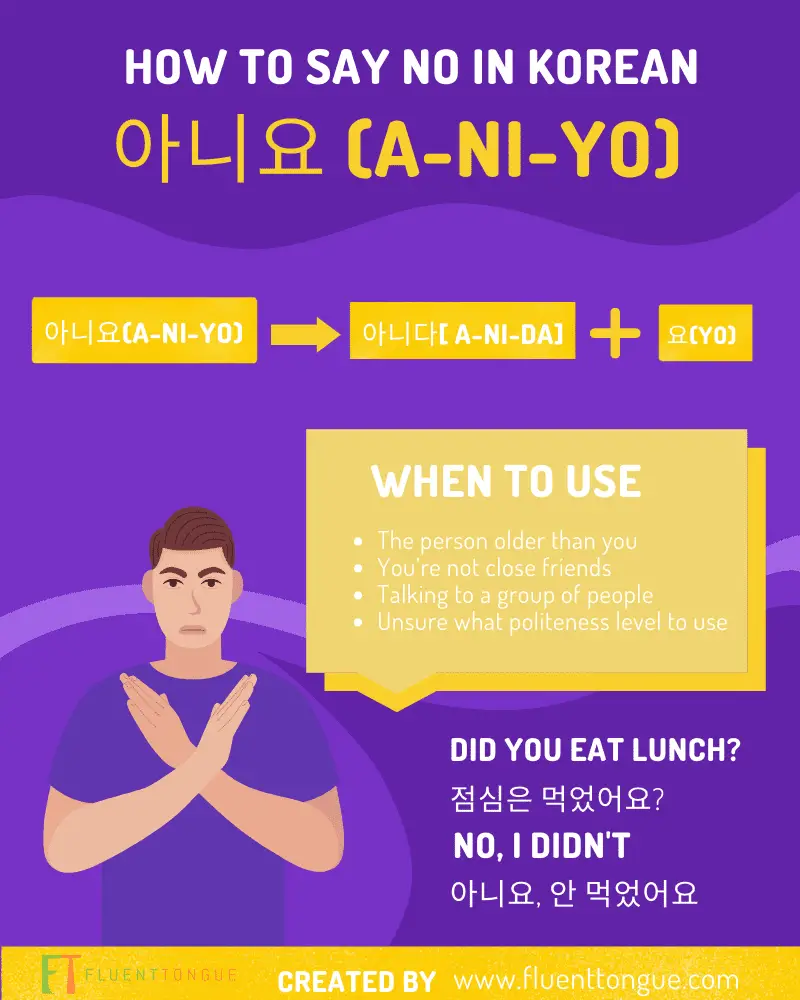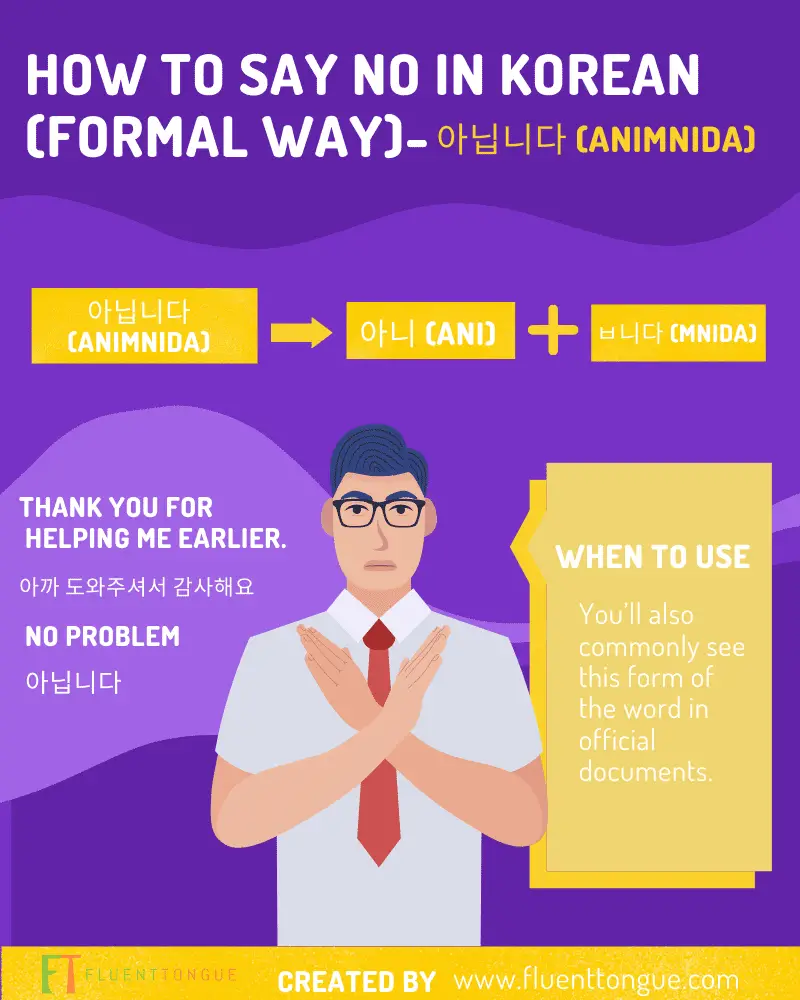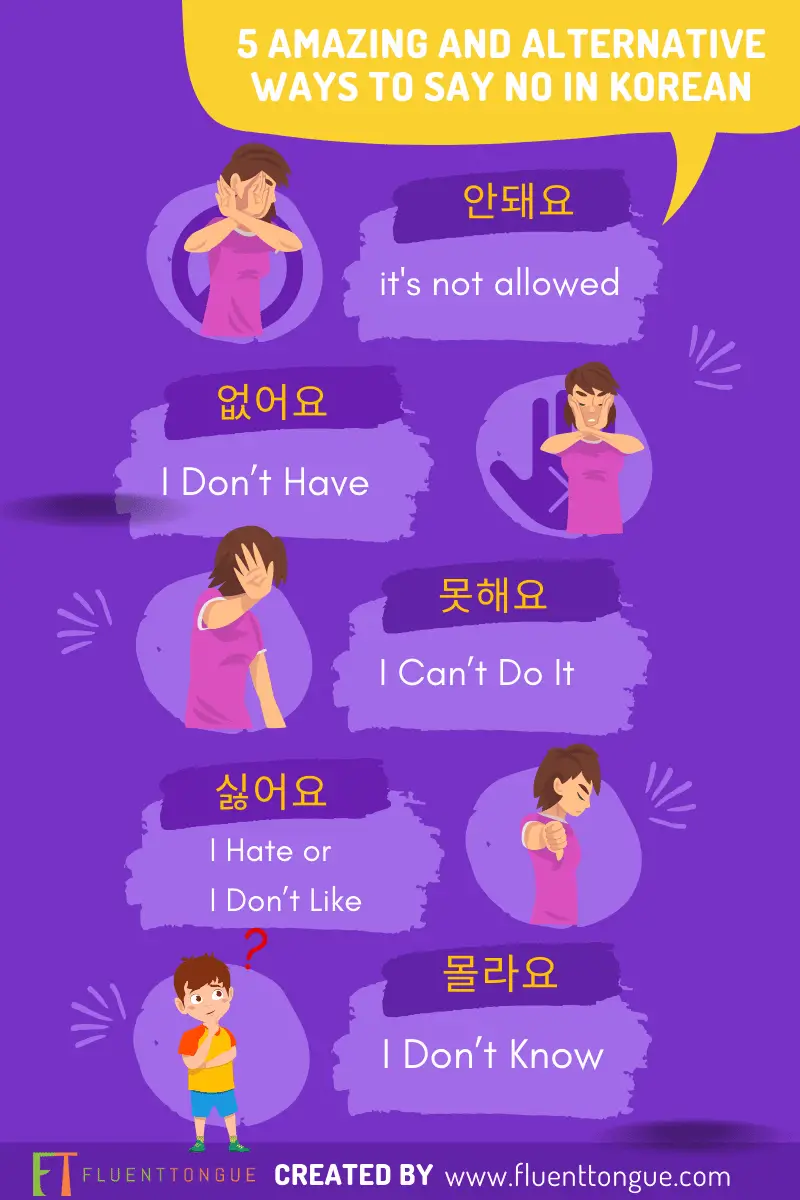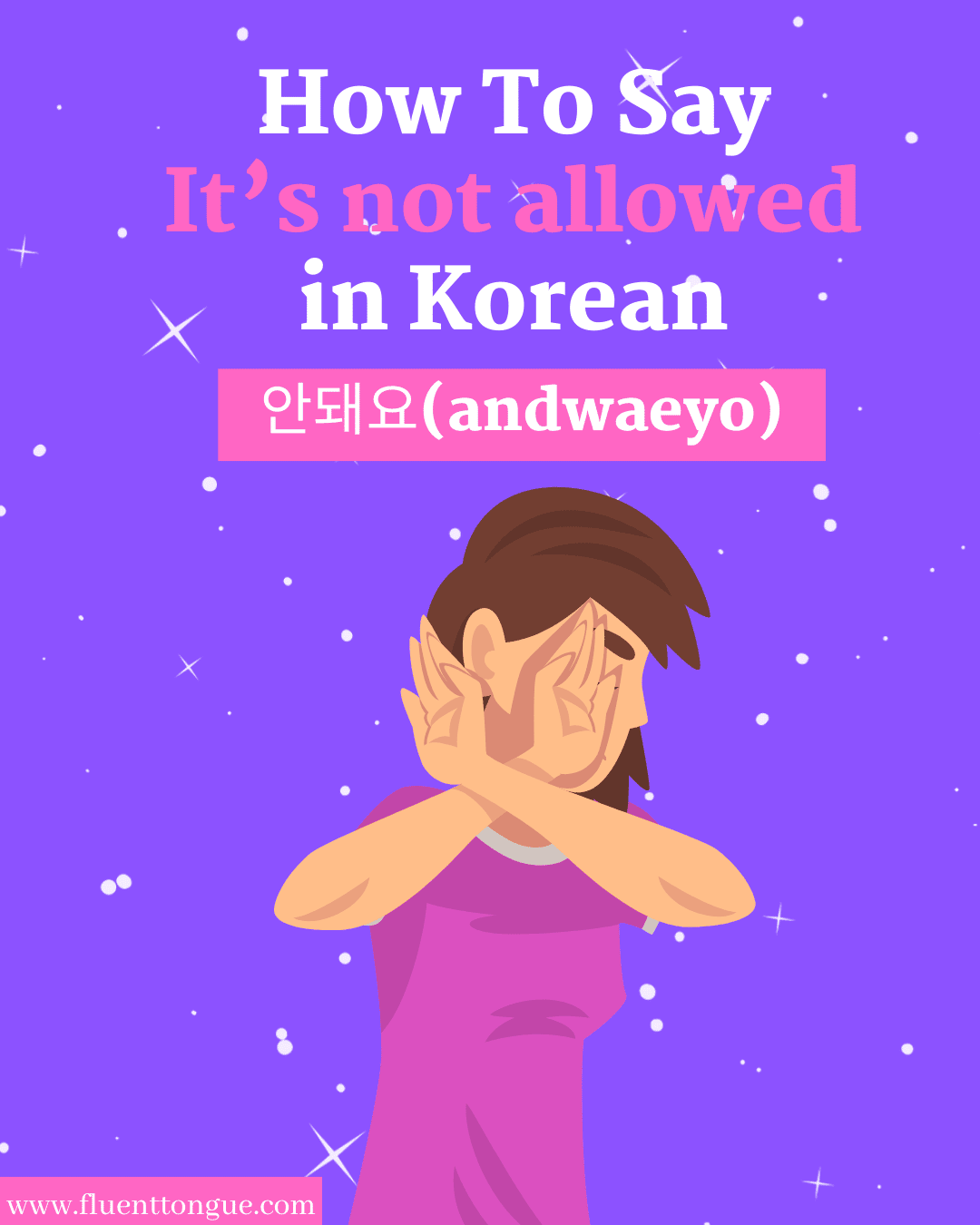Want to sound like a native while expressing a negative sentiment but can’t risk being rude?
Well, it’s time to learn to say no in Korean.
The most standard way to say no in Korean language is 아니요 (a-ni-yo) and it comes from the Korean verb 아니다a-ni-da means which really means “no/not”,
I agree. 아니요 (a-ni-yo) is short and simple but What to say when a simple “no” isn’t enough?
Luckily, it’s not that difficult.
In this lesson, we’ll show you when and how to say no in Korean like natives.
Here you’ll learn the “informal, polite, formal, and 9 alternative ways to say “no” with examples, and exercises to make sure you never sound rude to your friends and family.
All right world, Let’s get a little negative, shall we?
TABLE OF CONTENT
How To Say No In Korean Like a Native?|The Correct Way

Politeness is a must-have in Korean culture.
There are just times and days when we have to disagree or give them negative answers, but if you don’t want to be rude, then you can just use this greetings
The standard way to say no in Korean is 아니요 (a-ni-yo) and it comes from the Korean verb 아니다[ a-ni-da] which literally means “to be not”. To say “no” in a more casual way, you can drop the 요 ending and just say 아니 (a-ni).
Here are the common ways to say no in Korean language in causal, polite, and formal ways depending on the age of the person you are talking to and the situation
- The standard way to say no in Korean -아니요 (a-ni-yo)
- Informal way to say no in Korean – 아니 (a-ni)
- Formal way to say no in korean – 아닙니다 [ ah-neem-nee-dah ]
So with these expressions how do you figure out which one to use?
it’s important to study them in-depth so that you understand their meaning and use them correctly
So let’s learn in detail with examples
아니요 (a-ni-yo): The Standard and Polite Way To Say No In Korean

Even if you haven’t learned Korean, you must have heard of the word 아니요 (a-ni-yo), especially if you are a fan of K-drama.
아니요 (a-ni-yo) is the most basic form of saying no in Korean. It comes from the verb 아니다[ a-ni-da] means “to be not” with the ending ‘yo (요)’.
You can use this while saying no to an elderly person and want to add a sense of politeness to your response.
It can be shortened to 아뇨 (anyo).
Infobox
People are likely to use 아뇨 (anyo), when chatting online or in comic books or subtitles where speech is often written phonetically. It’s similar to saying “nah” or “nope” in English.
let’s see where you can use this phrase
When to Use
You should use this when
- The person you are talking with is older than you
- You’re not close friends with that person
- You’re talking to a group of people
- You’re unsure what politeness level to use
How to Use
Here are some sample sentences using your new word:
Do you like soju?
소주 좋아해요?soju joahaeyo
Yes
네- ne
이게 사과예요?- ige sagwaeyo
Yes, it is
네, 사과예요 – ne sagwaeyo
Let’s see some more example sentences
- Did you eat lunch?
점심은 먹었어요? – jomsimeun mogossoyo
- No,i didn’t
아니요, 안 먹었어요 – aniyo an mogossoyo
- Customer, Do you need a receipt?
고객님, 영수증 필요하신가요? – gogaengnim yongsujeung piryohasingayo
- No
아니요 – aniyo
민호씨, 내일 회사에 오나요?
- No
아니요,
- Do you want more kimchi?
김치 더 드실래요? – gimchi do deusilraeyo
- No, I am full.
아니요, 배불러요. – aniyo baebulroyo
- Do you know her?
그녀를 아세요? – geunyoreul aseyo
- No, I am not sure.
아니요, 잘 모르겠어요. – aniyo jal moreugessoyo
아니 (a-ni): How to Say “No” Casually in Korean?

Of course, not every situation is formal.
In some situations, you don’t have to stress about being polite like talking to your friends.
아니 (a-ni) is a common way of saying no in Korean in an informal or casual way. when you are talking with friends, siblings and those who are younger than you, just use 아니 [ ah-nee ] to express your disagreement.
When To Use
You can use the casual politeness level in the following situations:
- When talking to somebody younger than you
- When talking to somebody the same age as you
- When you agree with somebody that it’s okay to use it
- When talking to classmates you know are your age
How To Use
Here are some examples of how to use 아니 if you’re talking to a close friend.
Do you like soju?
소주 좋아해요?soju joahaeyo
Yes
네- ne
Is this an apple?.
이게 사과예요?- ige sagwaeyo
Yes, it is
네, 사과예요 – ne sagwaeyo
Let’s see some more examples
- Did you see that movie?
그 영화 봤어? (Geu yeong-hwa bwass-eo?)
- No, I didn’t see it.
아니, 안 봤어. (A-ni, an bwass-eo)
- Did you study English today?
오늘 영어 공부했어? (O-neul yeong-eo gong-bu-haess-eo?)
- No, I didn’t study today.
아니, 공부 안 했어. (A-ni, gong-bu an haess-eo)
- Is that a beer?
그것은 맥주예요? (geugeos-eun maekjuyeyo)
- No, it’s not a beer.
아니요, 맥주가 아니에요. (aniyo , maekjuga anieyo)
- Are you ready?
준비 됐니? – junbi dwaenni
- No, not yet
아니, 아직 -ani ajik
How To Say Yes in Korean
Formal ways to say thank you in korean: 아닙니다 [ ah-neem-nee-dah ]

Politeness is a must-have in Korean culture.
Well, at times, not everyone is going to like your negative response, especially the elderly or higher up socially, like a teacher, your boss, or strangers
아닙니다 (a-nib-ni-da) is the most formal way of saying no in Korean. It is made up of the word 아니 (ani) with the formal ending -ㅂ니다 (-ㅂ nida).
Its translation is “not to be,”/ “no problem”.You can use it when speaking to an unknown audience or if you are required to be more respectful.
아니 (ani) + ㅂ니다 (mnida) = 아닙니다 (animnida)
You might have the word 아니야 (aniya). The only difference is that 아니야 (aniya) is casual and 아닙니다 (animnida) is more polite.
While someone is expressing gratitude by saying thanks, you can use the word 아닙니다 (animnida) to say “no problem” or “don’t mention it.”
How To Say Thank You in Korean
When To Use
You’ll also commonly see this form of the word in official documents.
How to use
“Thank you for helping me earlier.”
아까 도와주셔서 감사해요. (Akka dowajusyeoseo gamsahaeyo.)
No problem.
아닙니다. (Animnida.)
I am not a student.
저는 학생이 아닙니다. (Jeoneun haksengi animnida.)
Yohan is not a doctor.
요한은 의사가 아닙니다. (Yohaneun uisaga animnida.)
Yohan is not British.
요한은 영국사람이 아닙니다. (Yohaneun yeongguksarami animnida.)
As you have learned how to reply no in Korean previously, you must know how to ask questions in Korean as well
clearly, there’s no point in knowing the answer When you don’t get what is being asked of you.
How To ask questions in Korean
The Difference Between 아니요 and 아니에요: Which one should you use?
Many people get confused about 아니요 (aniyo) and 아니에요 (anieyo) when learning Korean.
Here’s why
Both words look so similar, but they serve different functions.
And Here’s the basic difference between 아니요 (aniyo) and 아니에요
아니요 (aniyo) is the polite way to say no in Korean which is made up of two words i.e 아니 [a-ni] means ‘no’ and the ending 요 [yo]. It can be shortened to 아뇨(anyo). But (아니에요) means“it is not” and comes from the word “anida” (아니다) .아니야 (aniya) is used when you are speaking in an informal style.
And The funny thing is
Sometimes Korean mispronounce 아니에요(anieyo) as 아니예요(aniyeyo)
Let me explain with some examples
Example (Formal):
- Is it hot today?
오늘 날씨가 덥나요?- oneul nalssiga domnayo
- No
아니에요(anieyo)
NOTE
When the question includes a descriptive verb (like here [덥다 ] means “to be hot”) you can use 아니에요(anieyo). But it is also correct to use 아니요 (aniyo)
- Shall we meet today?
오늘 만날까요? – oneul mannalkkayo
- No, I’m busy
아니요, 바빠요.-anyo, bappayo
Example (Informal):
- Are you Japanese?
일본사람이야? (ilbonsaramiya)
- I am not Japanese.
아니, 일본인 아니야.ani ilbonin aniya
Difference Between 아니오. [ ah-nee-oh ] And 아니요 [ Ah-Nee-Yo ] In Korean
Have you ever the word 아니오. [ ah-nee-oh ] ?
Korean learner often gets confused while both 아니요 [ Ah-Nee-Yo ] and아니오. [ ah-nee-oh ] to say “no”
Both are formal ways to say no in Korean.
The only difference between 아니요 [ ah-nee-yo ] and 아니오 [ ah-nee-oh ] is that 아니요 [ ah-nee-yo ] is more commonly used in modern Korea. 아니오. [ ah-nee-oh ] is the old style of saying “no” in Korean and not used anymore
You might have heard 아니오. [ ah-nee-oh ] often while watching traditional Korean dramas.
Example:
In old Korean
- Are you busy?
바쁘세요? (bappeuseyo)
- No.
아니오. (anio)
You may hear the “오 (o)” endings in examples like “기다려 주십시오 (gidaryeo jusipsio)
In modern Korean
- Are you busy?
바쁘세요? (bappeuseyo)
- No.
아니요 [ ah-nee-yo ]
how do you say yes and no in Korean?

Apart from other fundamental Korean phrases like saying sorry, goodbye, and hello in Korean language, it’s essential for you to know what Korean words you can use to signal either affirmation or disagreement.
This is why I brought up today’s topic “How to answer tricky yes and no questions in Korean?”
But answering negative yes and no questions in Korean and English is the complete opposite.
In fact, it’s very confusing sometimes
but I promise you
It’s as easy as pie once you know how it works.
Here’s how to say and answer yes and no questions in Korean
In English, it’s about the fact, whether it’s true or not, and the same for both negative and positive questions.
But to reply to questions with yes and no in Korean it’s more about the agreement.
네 expresses your agreement with what the person is saying. 아니요 expresses your disagreement with what the person is saying.
Still confused?
Let me explain with examples
Minji: Do you like coffee?
민지: 수지씨,커피 좋아해요? – sujissi,kopi joahaeyo
Suji: yes, I like it
수지: 네, 좋아해요- suji, ne joahaeyo
Minji: Do you like tea?
민지: 수지씨, 차 좋아해요?-minji: sujissi ,cha joahaeyo
Suji: no, I don’t like
수지: 아니요, 안 좋아해요 – suji: aniyo an joahaeyo
If you’re asked in Korean, “You don’t drink coffee?” and it’s not your favorite, the answer is “No” in English.
In Korean, it would be “네” which means you agree with the negative question.
However, if the person DOES like coffee, he/she will say “Yes” in English but “아니요” in Korean. This means you didn’t agree with him/her.
While asking a negative question
Minji: Don’t you like coffee?
수지씨,커피 안 좋아해요?- sujissi ,kopi an joahaeyo
Suji: no, i like coffee
수지: 아니요, 좋아해요 – aniyo, joahaeyo
Minji: Don’t you like tea?
수지씨,차 안 좋아해요?- sujissi, cha an joahaeyo?
Suji: Yes, I don’t like tea.
수지: 네, 안 좋아해요?- suji: ne an joahaeyo
5 Amazing and Alternative Ways to Say No in Korean Language.

I know, in a polite society like Korea, a simple 아니요 [ Ah-Nee-Yo ]goes a long way
But what about the times when “아니요” just wouldn’t suffice?
Why
when expressing a negative sentiment, there are so many ways of doing it, from giving a blank stare to shaking one’s head to screaming “NO!” at the top of your lungs.
So it’s important to learn the right expression for every occasion.
Apart from 아니요 [ Ah-Nee-Yo ], Here in this article, we’ll take a look at the different ways to say no to you in Korean
Let’s see what they are!
how to say 안돼요(andwaeyo)- It’s not allowed in Korean

If something is not possible to do/ not allowed to, you may say 안돼요(andwaeyo) means “you cannot”.
If you want to say it in a casual way you can just say “안돼(andwae)”. Basically “안” means no in Korean.
Example sentences
How do you say 없어요- I don’t have in Korean

없어요 means I don’t have/ it doesn’t exist. When you say you don’t have something in Korean, you can use this expression. “없어” is a conjugation of the verb 없다 [updah] means “ to not have” or “ to not be”.
To say “you don’t have something” in Korean, all you have to do is add the noun and 없어요 at the end.
Noun + 없어요
Example
- I don’t have money
돈이 없어요
- I don’t have homework today.
나는 오늘 숙제가 없어요- naneun oneul sukjjega opssoyo
- I don’t have a car
난 차가 없어. – nan chaga opsso
- I don’t have a pet
애완동물이 없어요 – aewandongmuri opssoyo
- I don’t have extra kimchi stew.
김치찌개 여분이없어요 – gimchijjigae yobuniopssoyo
못해요 (mothaeyo) – how to say “I can’t do it” in Korean

못해요 (mothaeyo) means “I can’t do it” in Korean. It is a very short and direct way to say “no” in Korean when you are talking about things that you are not capable of.
To say I can’t in Korean, All you need to do is just take the verb stem and add 지 못하다/ 못하다( in case of 하다 verb).
Remember that 못 (mot) is related to one’s inability to do something.
Here’s the grammar structure to say I can’t in Korean
Verb stem + 지 못하다
If the verb ends with 하다, you can directly use
Verb stem + 못하다
Example Sentences
- I can’t drive.
나는 운전을 못 해요.-naneun unjoneul mot haeyo
- I don’t speak Japanese.
일본어를 못해요 – ilbonoreul motaeyo
- I’m sorry I can’t help you today, I’m really busy.
오늘 도와드리지 못해 죄송합니다, 제가 너무 바빠서요.
oneul dowadeuriji motae jwesonghamnida jega nomu bappasoyo
싫어(요): how to say I hate/ I don’t like in Korean

If you don’t like something, you can use the word 안 좋아[an joah]. 싫어[shil uh] also means hate or I don’t like in Korean. 좋아 is a verb that is a conjugation of 좋다 means “to like”.
싫어 is a conjugation of the verb 싫다 means to dislike
Here are the common ways to say I don’t like/hate in Korean informal, casual, and polite way
- The Polite Way – 안 좋아해요[an joahaeyo]
- The causal way – 안 좋아해[an joahae]
- The formal way – 좋아하지 않습니다[joahaji anseumnida]
- Polite form (using the verb 싫다)- 싫어요 [siroyo]
- Causal form (using the verb 싫다)- 싫어 [shil uh]
- Formal form (using the verb 싫다)- 싫어합니다 [sirohamnida]
Example
- I don’t want to study
공부하기 싫어- gongbuhagi siro
- I just hate doing laundry.
전 그냥 세탁하는 게 싫어요.
- I hate to dance.
난 춤추는 게 아주 싫어.
- I don’t like galbi.
갈비 싫어요 – galbi siroyo
- I don’t want to work on Saturday
토요일은 일하기 싫어요.-toyoireun ilhagi siroyo
- I don’t like tomatoes and radishes.
나는 토마토나 랑 무 안 좋아-naneun tomatona rang mu an joa
- I hate all vegetables. I’m only going to eat meat.
야채 다 싫어.고기만 먹을 거야-yachae da siro gogiman mogeul goya
몰라요 [mol-la-yo]: How do you say I don’t know in Korean?

It’s a great way to use when you don’t understand what’s going on or you have no clue about what the others are saying
몰라요 [mol-la-yo] means I don’t know in Korean which comes from the verb 모르다 (means ‘to not know’). The casual way is 몰라 [mol-la] comes from the verb 모르다 and means ‘to not know’.
The formal way to say ‘I don’t know’ in Korean is 모릅니다 [mo-reum-ni-da] consists of the verb 모르다 plus the formal ending ~(스)ㅂ니다.
you can use this when you want to be respectful.
Here’s another way
모르겠어요 [mo-reu-gae-sseo-yo] is another common way to say ‘I don’t know in Korean. It comes from the verb 모르다 (to not know) plus the ending 겠, which in this context is similar to the word ‘guess’.
Here is a list of common ways to say ‘I don’t know in Korean(including the casual, polite, and formal ways) with hangul and pronunciation.
- Polite form: ‘I don’t know in Korean – 몰라요 [mol-la-yo]
- Causal form: ‘I don’t know in Korean – 몰라 [mol-la]
- Formal form: ‘I don’t know in Korean – 모릅니다 [mo-reum-ni-da]
- Polite/soft form: ‘I don’t know in Korean -모르겠어요 [mo-reu-gae-sseo-yo]
- Formal/soft form:‘I don’t know in Korean -모르겠습니다 [mo-reu-gae-ssum-ni-da]
Let me explain with examples
If you want to say “I don’t know Korean” which is translated as 한국어 몰라요 [hangugo molrayo], just take the noun(here it is Korean) and add 몰라요 [mol-la-yo] next to it.
- ‘What’s the answer?’ ‘I don’t know.’
“정답이 뭐지?” “몰라.”
- How long does it take from your house to your company? I don’t know
집에서 회사까지 얼마나 걸려요?몰라요
- I don’t know what to say.
무슨 말을 해야 할지 모르겠어요.
- I don’t know where the money goes!
그 돈이 어디로 나가는지 모르겠어!
- .I don’t know his number.
그의 전화 번호를 몰라요
- Don’t ask me. I don’t know his name or last name.
나한테 묻지 마. 난 그 사람 이름도 성도 몰라.
- Will you be able to help us?’ ‘I don’t know
저희를 도와주실 수 있으시겠어요?” “모르겠어요.
Making Negative Commands: How do you say “Don’t / Don’t Do That” In Korean?

In order to ask someone not to do something, you just need to put the verb stem in front of 하지마 (ha-ji-ma)/ 하지마세요 (ha-ji-ma-se-yo).
Here’s how
Let’s say “Don’t talk” you can say like 이야기 하지 마세요(iyagihaji maseyo)
- Don’t do that (casually): 하지마 (ha-ji-ma)
- Don’t do that (polite): 하지마세요 (ha-ji-ma-se-yo)
Example sentences
- Do not talk in the library
도서관에서 이야기하지 마세요.”- dosogwaneso iyagihaji maseyo
- Don’t drink and drive
음주 운전을 하지 마세요.-eumju unjoneul haji maseyo
- Don’t waste your money.
돈을 낭비하지 말아요.- doneul nangbihaji marayo
- Don’t dump garbage here.
여기에 쓰레기를 버리지 마세요.-yogie sseuregireul boriji masey
- Don’t make fun of people.
사람을 놀리지 마세요.-sarameul nolriji maseyo
- Don’t look at me that way.
그런 눈으로 쳐다보지 마세요.-geuron nuneuro chodaboji maseyo
How do you say “NO WAY/no way, I don’t believe it “ In Korean?

설마! 말도 안돼[Solma! maldo andwae] means “no way! I don’t believe it” in Korean.
You can use this phrase when you hear something that is ridiculous and you think it’s hard to believe.
However, if you want to say this expression to someone who is older than you, just put 요 at the end of sentences.
and say like 설마요! 말도 안돼요[solmayo,maldo andwaeyo]
Here are two common ways to say no way, I don’t believe it in Korean
- Informal way: 설마! 말도 안돼[Solma! maldo andwae]
- Formal way: 설마요! 말도 안돼요[solmayo,maldo andwaeyo]
There’s also a Korean slang for this phrase i.e. 헐! 뻥지시마[heol! Ppong chi ji ma] means omg/no way! I don’t believe it.
Let’s take a look at this conversation between Ha Joon and Min Jun
- Ha-Joon: Min jun! Did you hear the news?
하준: 민주야,너 그 뉴스 들었니?-minjuya, no geu nyuseu deuronni
- ha joon: no
민주: 아니
- Min Jun: I won the lottery
민주: 복권에 당첨됐어.- bokkkwone dangchomdwaessoyo
- Ha Joon: no way.
하준: 설마![Solma]
- Min jun: I received 100 million won.
민주: 1억 원을 받았다.-il ok woneul badattta
- Ha Joon: Really! I don’t believe it
하준: 진짜?말도 안돼[jinjja! maldo andwae]
- Min jun: let’s go for shopping
민주: 나도 그래, 쇼핑하러 가자 -nado geurae,syopingharo gaja
- ha joon: yes, let’s go
하준: 그래, 가자 [geurae gaja]
Infobox
Korean also use 그럴리가[geurolriga] means it can’t be or 절대 안돼[joldae andwae] literally means no way. You should never do it.
Other Negating Words and Phrases
Here is a list of common related Negating Words and Phrases you should know to say “no” in Korean
- Never – 절대로 (Jeoldaero)
- No One – 아무도 (Amudo)
- Nowhere – 어디에도 (Eodiedo)
- Not Particularly – 별로 (Byeolo)
- It’s Not My Fault. – 내 책임이 아니다 [Nae Chaegimi Anida]
- It’s Nothing – 아무것도 아니야.
- Of Course Not -당연히 아니지 [Dang-Yeonhi Aniji ]
- To Not Care / To Not Mind – 신경 쓰지 않다 [ Singyong Sseuji Anta]
- Don’t worry. – 걱정 마세요.[Gokjjong Maseyo]
- Don’t You Know Me? – 나 몰라[Na Molla]
- Not Really – 설마 [Seolma]
- No Problem – 괜찮아요
- There Is No Hope – 희망이 없어
- There Is No Way – 방법이 없다 [Bangbobi Optta]
How To Memorize No Korean In Minutes & Never Forget It?
Remember, the best way to learn a new skill or language is to practice. Try slipping some of the new expressions you learned today into your everyday conversations with friends and family.
If you are struggling, practice it in front of the mirror, or simply choose one of the many other options to get started.
So, why not start here?
Use flashcards and Test
I know it’s an old thing(you might be using Anki too)
But When it comes to mastering Korean vocabulary, you will never regret using these fellas.
We have 24 printable flashcards(printable and illustrated) for you. cut, print, and learn it or learn it on pc.
Choice is yours
Here’s another one
https://quizlet.com/504011734/no-in-Korean-flash-cards/
Other Online Resources
We live in the era of the 20th century.
And I bet you love to surf (well, who doesn’t?)
The internet is full of free stuff and language resources that you haven’t explored yet. Here is what I found when I was learning day of the week in Korean
Here is a list (I hope it might help you)
https://en.wikipedia.org/wiki/No_In
http://kref.altervista.org/krefnegativeform.html
https://en.wikipedia.org/wiki/Korean_verbs#Negative_prefixes
Conclusion and Korean Quiz
You have just learned 10 different ways to say “no” in Korean. To really internalize these expressions, try coming up with your own examples to understand the different usages and contexts of the word.
Even better
Learn them in the context of a story, so you understand not only the meaning but also the intent behind it.
If you to be a great example to your friends and family, seize the opportunity to be the master of all languages now
Can you think of more ways of saying “no” in Korean? Please add them to the comment below – with an example if possible.
Good luck with your studies and remember, repetition is the key!
